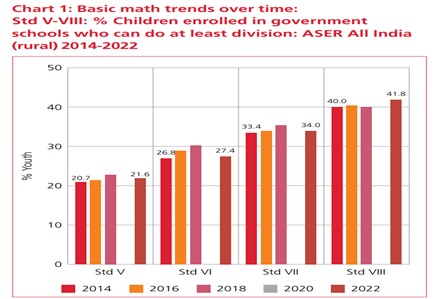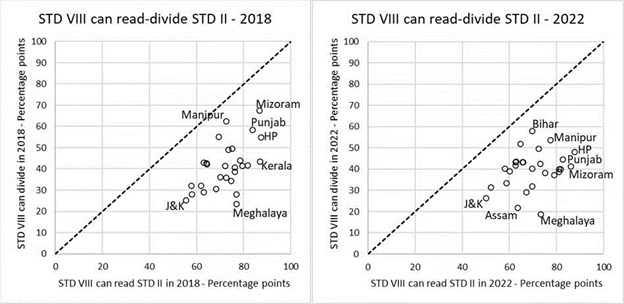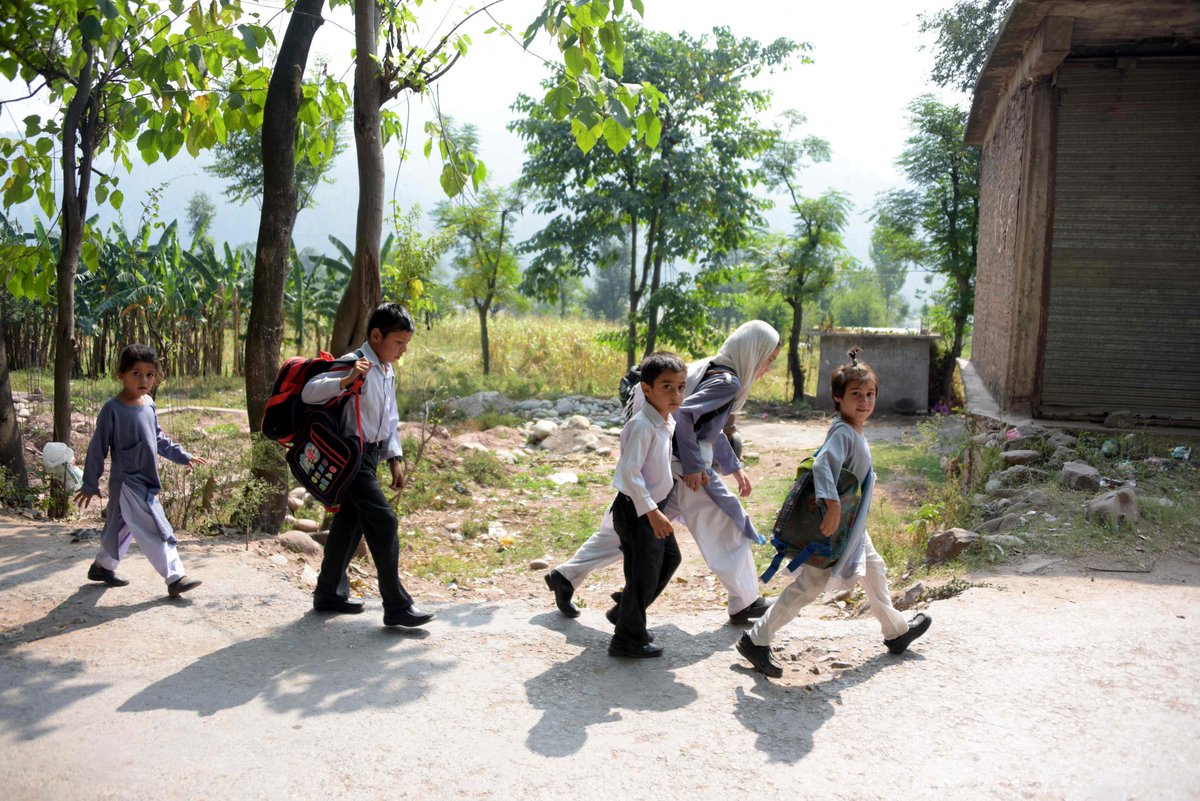Education stands as the cornerstone of human progress. It is a gateway to opportunity, the catalyst for innovation, and the engine driving social transformation. It is a transformative journey that empowers individuals to reach their fullest potential. In the realm of education, enrollment rates are often seen as a beacon of progress, signalling increased access to learning opportunities for all. Yet, beneath the surface of high enrollment rates lies a pressing concern: the persistent challenge of low learning outcomes. Despite the efforts to expand access to education, every region grapples with the stark reality that enrollment alone does not guarantee quality learning. Kashmir is no exception. In this article, an attempt has been made to unravel the complexities of this vexing issue by scrutinizing the Annual Status of Education Report (ASER) reports. The article discusses the underlying challenges contributing to the gap between enrollment and learning outcomes and explores potential solutions to bridge this divide for the betterment of individuals and societies alike.
A Learning Deficit: Insights from ASER Reports
The latest Annual Status of Education Report (ASER) 2023, titled “Beyond Basics” reveals that more than 86.8% of individuals in the age group of 14-18 are enrolled in educational institutions. While commendable strides have been made towards achieving the national goal of attaining 100% GER, concerns persist regarding the learning deficit among students. Despite high enrolment rates, there doesn’t seem to be much change in their foundational literacy and numeracy skills. According to the report, one-fourth of children enrolled struggle to read a Class 2-level text fluently in their regional languages. Comparing data from 2017 to 2023, the percentage of 14-18-year-olds proficient in reading Class-2 text has slightly declined from 76.3% to 73.6%.
Moreover, as per the data from the ASER 2023 report, a staggering 56.7% cannot perform simple division. Children in India continue to struggle with basic arithmetic skills even after reaching class 10 and higher levels of education. The disheartening trends for students who can do at least a 3-digit by 1-digit numerical division calculation are shown in the chart below.

Image source: ASER survey titled ‘Beyond Basics’, 2023
ASER report 2023 presents comprehensive insights into the educational landscape in the Anantnag district of South Kashmir. It reveals that in terms of the enrollment and work status of youth in the age group of 14-16 years of age in Anantnag, 3.9% of youth- male 1.7%, and female 5.5% are not enrolled in schools. While 61% of youth in the same age group (male: 59.5% and female: 62.1%) are enrolled in government institutions, a meagre 0.4% are enrolled in vocational training or other courses. The report further states that around 76.5 percent of youth in the age group of 14-16 years can read at least standard 2nd-level text whereas it stands at 79% for youth in the age group of 17-19 years. In the age group 14-16 years, 39.3 percent of youth can divide and 87.2% of youth can read sentences in English. While in the age group of 17-18 years, 30.5% of students can do division and 86% of students can read sentences in English.
Since ASER 2023 is limited to surveying only the Anantnag district of Jammu & Kashmir, ASER 2022 is also scrutinized to get a holistic understanding of the educational landscape of Jammu & Kashmir. As per the ASER report 2022, the enrolment number of children in the 6-14 age group stands at 55.5 percent in 2022. This achievement seems a little laudable because the trends in basic learning have remained relatively unchanged over the years in J&K. The graph below represents the state-wise percentage points of government school children in Std VIII who can read Std II level text and who can do division. The closer the point to the origin, the lower the overall reading-arithmetic performance. The graph clearly shows that Jammu and Kashmir is the closest point to the origin thus, reflecting the lowest overall reading-arithmetic performance. The forthcoming section will now delve into the specific challenges faced by the education system of the territory.

Challenges facing the education system of Jammu & Kashmir
Before we delve into the discussion of policy recommendations for improving the educational landscape, it becomes imperative to examine the challenges faced by the region’s educational system. Despite children being enrolled in school, poor learning outcomes have emerged as a stark reality. A significant contributing factor to this issue is the lack of engagement in many classrooms. Student engagement is widely recognized as a key driver to better learning, yet it remains conspicuously absent in numerous educational settings. The many problems that plague the prevailing education system, including, inadequate teacher allocation, poor systemic governance, lack of teacher training, and outdated teaching practices, all make student engagement a tough task. Notably, the ‘JK Vision document 2047’ underscores the critical need for skilled human resources in teaching, revealing that over 36,000 ReTs or RReTs lacked the desired level of qualification.
In addition to the shortage of trained and qualified teachers, financial constraints have severely impacted the educational infrastructure in the region. ASER report 2022 presents a grim picture of infrastructure and sanitation facilities in educational institutions. The report highlighted that 30 percent of schools in Jammu and Kashmir lack water facilities while around half of schools in Jammu and Kashmir have a shortage of girls’ toilets. Furthermore, another study reveals that until October 02, 2023, at least 61% of government-run schools in Jammu and Kashmir, cast doubts on the education department’s commitment to infrastructural developments. The situation is further exacerbated by the fact that at least 51 government schools operate from rented accommodations across four education zones in north Kashmir’s Bandipora district.
Gender disparities persist in Kashmir, resulting in higher dropout rates among girls, particularly between the age of 15-16 years. Socio-cultural norms, economic constraints, and ignorance of parents serve as major obstacles to achieving gender equality in education. Moreover, the region’s education system grapples with unique challenges deeply rooted in its history of political instability. Decades of political unrest and tensions have disrupted normal life, including educational institutions, leading to frequent closures, curfews, and disruptions in academic calendars. To sum up, the educational landscape of Jammu & Kashmir faces multifaceted challenges, ranging from longstanding conflicts to infrastructural deficiencies, inadequacy of trained teachers, and gender disparities. Addressing these challenges demands concerted attention and effort. The last section will now outline several recommendations aimed at addressing these issues and improving the educational scenario.
Policy recommendations
Urgent measures are required to ensure quality education for every child and to meet the goals and targets of Agenda 2030. “Catch-up” initiatives for foundational literacy and numeracy are the need of the hour for a significant portion of the 14-18 population. Structured lessons, high-quality teacher-student relationships, and student autonomy, including allowing students choices in the classroom should be the immediate step. Now is the time to shift from a one-size-fits-all approach to creating multiple paths for students to achieve their goals. The curriculum must be aligned with the evolving requirements of the job market and global trends. Additionally, digital literacy should be integrated into the curriculum at the earliest to ensure that students are proficient in using technology responsibly and effectively.
In addition to endeavours to enhance learning outcomes, the government must tackle the financial constraints for adequate infrastructure. Adequate resources must be allocated for the construction and renovation of schools, especially in rural and urban areas. Furthermore, skill development programs are crucial to equip the region’s youth with the necessary vocational skills and training to enhance their employability and entrepreneurship opportunities. Harnessing the potential of technology holds the key to unlocking new horizons of opportunity and progress. Interactive learning platforms, e-learning courses, digital classrooms, and online assessment and feedback mechanisms are some examples of using technology to improve the quality of education.
Integrating technology into the education system will cater to the needs of different types of learners, allowing them to move away from rote learning and tackle real-world challenges. However, no advancement in technology can overshadow the pivotal role played by teachers in improving learning outcomes. Therefore, the government must prioritize teacher recruitment and training. Teachers should be trained in new competencies and skills to facilitate 21st-century education by combining curriculum and technology. Technology must complement teaching, and enhance engagement rather than replace teachers.
Lastly, it should be kept in mind that ensuring quality education is not just a duty of government rather it is a collaborative and collective endeavour. To develop a vibrant educational ecosystem, it’s essential to involve parents, community leaders, and local NGOs. Awareness campaigns and school committees must be established to engage these stakeholders actively. Community involvement remains at the heart of enhancing student engagement. It’s time to work collectively to pave the path for a robust, inclusive, and sustainable education system.
References:





Leave a Reply
You must belogged in to post a comment.